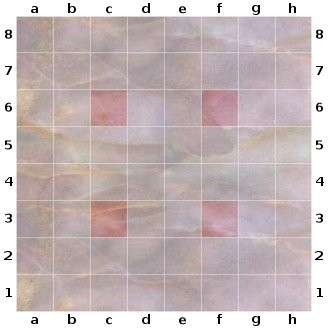Arimaa/Introduction to Strategy/Distribution of Force
< Arimaa < Introduction to Strategy

| |||||||||||||||||||||||||||||||||||||||||||||||||||||||||||||||||||||||||
| Silver needs a dog on each wing. | |||||||||||||||||||||||||||||||||||||||||||||||||||||||||||||||||||||||||
Strongest Piece
In the study of trap control, it is clear that the strongest local piece is more important than the second-strongest local piece. For example, a camel and a dog can take control of a trap against two horses, but not vice versa. The importance of the strongest piece generalizes to goal attack, goal defense, mobility fights, etc. In each situation a camel and a dog will be more effective than two horses.
Split Strong Pieces
One strategic consequence of the power of the strongest piece is that it is generally more effective to split strong pieces, both for attack and for defense. In the position at right, from this game, Gold has split his horse and dog, threatening to attack in the west with a dog and in the east with a horse. Neither piece has an equal counterpart on its wing, so either attack will force the silver elephant to defend. The silver elephant will soon be overloaded, unless Silver quickly gets a dog over to help in the west, somewhat neutralizing the gold dog.
Moreover, Silver has no use for two dogs in the east. Two dogs are just as incapable of taking over f3 from a horse as a dog and a cat, and as for defending f6 from a horse, a dog and a cat are just as good as two dogs. In the actual game, Silver did not split his dogs, and soon got into trouble. If he had balanced his forces, however, his elephant would have had a much easier time hovering near the gold horse, where it would like to be, rather than fending off the attack of a mere dog in the west.

| |||||||||||||||||||||||||||||||||||||||||||||||||||||||||||||||||||||||||
| Material is even, but Gold controls three of four quadrants. | |||||||||||||||||||||||||||||||||||||||||||||||||||||||||||||||||||||||||
Win By One
Because the strongest local piece is most important, the most efficient use of force is for each piece to dominate the next-weaker opposing piece, while avoiding the next-stronger opposing piece. Elephants should attack camels, camels should attack horses while avoiding elephants, horses should attack dogs while avoiding camels, etc.
This generalizes the principle of horse hostages, namely that in the opening, horses don't need to be as afraid of elephants as they need to be afraid of camels.
An extreme example of the power of winning by one is diagrammed at left. Each side has an elephant, a camel, a horse, and a dog, yet Gold is locally winning three fights, whereas Silver is winning only one.
Note that the principle of winning by one often conflicts with the principle of splitting strong pieces. For example, one would prefer to have one's elephant and camel operating on opposite wings, but if the opposing elephant is about to take one's camel hostage, it usually pays to use one's elephant to rescue the threatened camel, even if that temporarily puts both strong pieces on the same side. Another example is that when the opposing camel is committed to one wing, it may pay to shift both of one's horses to the other wing, even though typically one would want a horse on each wing.
One-Gap Tandem
One case in which splitting strong pieces and winning by one work together is the opening elephant-horse attack. First, this attack splits the friendly elephant and camel. If the opposing elephant defends against the EH attack, the friendly camel is still free to operate on the rest of the board. This is in contrast to an elephant-camel attack which can be defended by the opposing elephant, leaving the opposing camel unmatched on the rest of the board.
A more subtle point of the elephant-horse tandem is that it may confuse the opposing camel. The opposing camel would like to take an attacking horse hostage, but also would not like to be taken hostage by the attacking elephant. How the camel should respond to an EH attack is a tricky issue even for humans, but so far it absolutely baffles computers, and explains why humans can win against programs either attacking with EH or defending against it.
The idea of using the strongest and third-strongest pieces as an attacking tandem still applies after exchanges have depleted the board. In the first diagram of this page, Gold would much rather attack with elephant and dog than with elephant and horse. Note that the second-strongest and fourth-strongest piece can make a very effective backup tandem: Gold's horse-cat tandem is nearly as strong as a horse-dog tandem would be, but it spares the dog for use in the primary attacking tandem.